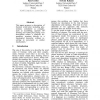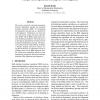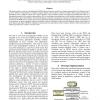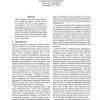102 search results - page 3 / 21 » Using Syntactic Dependencies For Word Alignment |
ACL
2001
13 years 10 months ago
2001
This paper proposes a description of German word order including phenomena considered as complex, such as scrambling, (partial) VP fronting and verbal pied piping. Our description...
EMNLP
2010
13 years 6 months ago
2010
We reveal a previously unnoticed connection between dependency parsing and statistical machine translation (SMT), by formulating the dependency parsing task as a problem of word a...
COLING
1996
13 years 9 months ago
1996
In this paper, we describe a new model for word alignment in statistical translation and present experimental results. The idea of the model is to make the alignment probabilities...
LREC
2010
13 years 10 months ago
2010
This paper presents a word sense disambiguation (WSD) approach based on syntactic and logical representations. The objective here is to run a number of experiments to compare stan...
EMNLP
2004
13 years 10 months ago
2004
Given a parallel parsed corpus, statistical treeto-tree alignment attempts to match nodes in the syntactic trees for a given sentence in two languages. We train a probabilistic tr...




